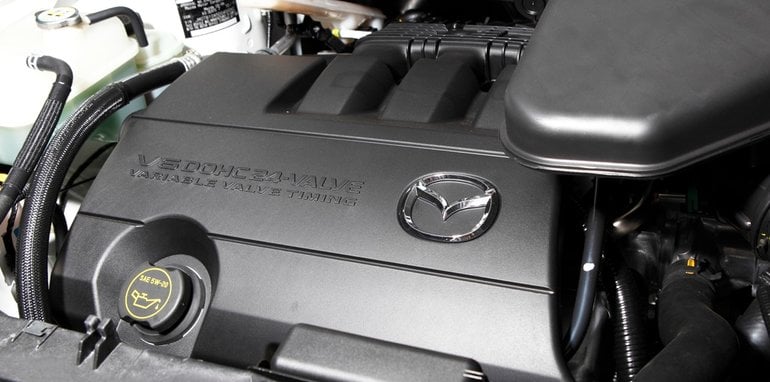The next-generation Mazda CX-9 SUV will lose its V6 petrol engine, likely in favour of a more efficient turbocharged four-cylinder.
Mazda global head of sales and marketing, Masahiro Moro, indicated to CarAdvice at the New York auto show that Mazda is in a transition period away from the Ford-sourced V6 seen in the current CX-9.
“We stopped production of our own V6 in the late 1990s. We have used Ford V6 [up until today, and that engine is still used in the CX-9]. Since then everybody is putting in a downsized turbocharged solution.”
Moro suggested the Japanese brand may follow suit in dropping the six-cylinder in favour of a four-cylinder turbo for the next-generation model, which is expected to be launched by 2016.
“I think that turbocharging technology has improved a lot,” he said of the thirsty 2.3-litre four-cylinder turbo that was used in the now defunct Mazda CX-7.

“But obviously a question is whether we put in two more cylinders or use turbocharge, which is cost-effective and [offers] better performance. That’s always a good question for engineers.
“If I ask Mr Hitomi, our top guy of powertrains at Mazda, he believes the downsizing turbo solution costs more. But real downsizing means six-cylinder to four-cylinder turbo could make sense from a cost point of view. But four-cylinder to four-cylinder doesn’t make sense,” he said of reducing engine capacity and power.
“You can make it bigger displacement with four-cylinder, that is cost-friendly. As long as you can get better fuel economy.”
Obvious alternatives include a conventional turbo diesel drivetrain, as many competitor cars such as the Kia Sorento, Hyundai Santa Fe, Ford Territory and Holden Captiva offer.
But Moro said that due to the fact the CX-9 is most popular in the US and customers there choose petrol almost by default, a diesel CX-9 is unlikely.

“With the CX-9 the main market is the USA. In general, these customers don’t have a strong preference towards diesel engines. So probably the main engine should be a petrol engine in my opinion.”
Moro said a diesel wasn’t ruled out, and indeed it would be more likely than a hybrid powertrain, as competing vehicles like the Nissan Pathfinder hybrid and Toyota Kluger [Highlander] hybrid. Neither of those cars are currently sold in Australia, though the Nissan is expected to arrive this year.
“A fuel-efficient petrol engine or diesel engine [would be preferable] where it’s possible. Hybrid is not really a high priority for us other than in the Japanese market,” he said. “It depends on the driving condition of each market. In Australia and the USA, people drive longer mileage, on the highway for example. I think real-world fuel economy, for example, a diesel engine would be better.”
Despite the axe looming over the current V6 and plenty of alternatives being investigated, Mazda won’t be moving away from six-cylinder engines altogether, according to Moro.
“As Mazda is moving up towards premium territory, at some point in time we will need a six-cylinder,” he said. “It’s too early, we don’t have a car yet. But we are collecting advice as to V6 or straight six.”